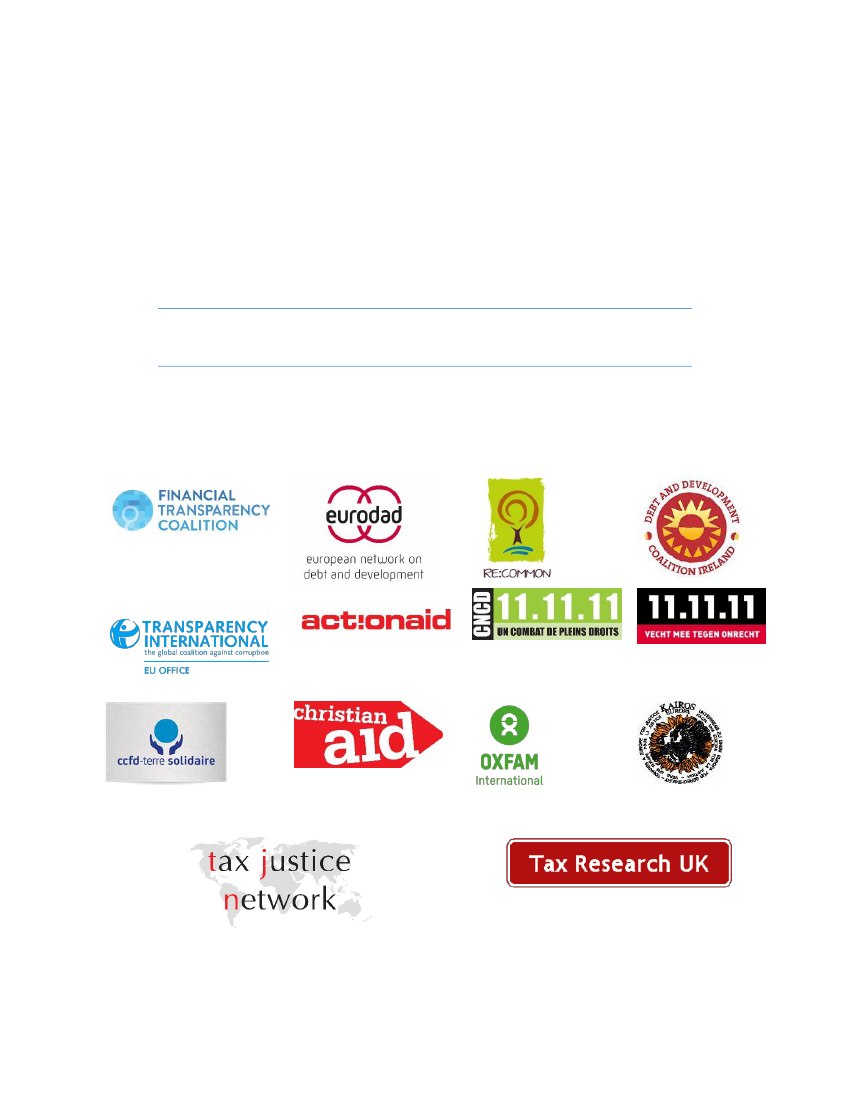Europaudvalget 2015-16
EUU Alm.del Bilag 506
Offentligt
Why Public Country-by-Country
Reporting for Large
Multinationals is a Must
Questions and Answers
24/02/2016
1
EUU, Alm.del - 2015-16 - Bilag 506: Civilsamfundsorganisationers papir om land for land-rapporteringer
Questions & Answers
Introduction .................................................................................................................................................. 3
1.
2.
3.
4.
5.
6.
7.
8.
9.
10.
11.
Is this only important for tax transparency?......................................................................................... 4
Is this only relevant to tax administrations? ......................................................................................... 5
Will transnational enterprises incur an undue cost burden? ............................................................... 6
Will trade secrets be disclosed?............................................................................................................ 8
Will transnational enterprises become less competitive?.................................................................... 9
Are transnational enterprises too complex for public CBCR? ............................................................ 10
Will more information create confusion and instability? ................................................................... 10
Is public CBCR important for only the EU governments? ................................................................... 12
Can the European Union go further than the OECD? ......................................................................... 13
Can we rely on information exchange between governments? ..................................................... 14
Has the US ruled this to be ‘unconstitutional’? .............................................................................. 15
2
EUU, Alm.del - 2015-16 - Bilag 506: Civilsamfundsorganisationers papir om land for land-rapporteringer
Introduction
Abusive tax planning by transnational enterprises is a global problem. A major part of global cross-border
trade happens between related parties in a transnational enterprise and almost 1/3 of global corporate
investment stocks passes through offshore investment hubs.
1
This type of trade is susceptible to abusive
exploitation of gaps and loopholes in domestic and international tax law that allow for ‘profit shifting’
from country to country, with the intention of reducing the taxes paid on profits.
A lack of transparency makes this kind of tax planning difficult to quantify. Enhancing transparency in the
way transnational enterprises report and publish their accounts, would help tackle tax avoidance at very
low cost.
Despite publishing their accounts as if they are unified entities, transnational enterprises are not taxed in
this way. Each business entity within the transnational enterprise is taxed individually, making it difficult
to establish an overview of what is happening within a group of companies for tax purposes. This would
be different if reporting was done on a ‘country-by-country’ basis.
Since 2015 the European Union requires large financial institutions to do so, which has led to a barrage of
media reports of banks that get away with paying very little tax.
2
It also has allowed investigators to
compare banks in terms of their attitudes to using low- or no-tax jurisdictions in their corporate structures.
Based on these experiences the European Parliament voted overwhelmingly in favour of a proposal for
the Shareholders Rights Directive (SRD) that would extend similar country by country reporting (CBCR)
obligations to all sectors of the economy. This measure would require companies that qualify under
certain criteria to report yearly and on a consolidated basis on the following items, among others: 1. the
name(s) and nature of their activities in each jurisdiction where they operate, 2. the turnover, 3. profit or
loss before tax, 4. tax on profit or loss, 5. number of employees and 6. public subsidies received.
In addition to the current requirements for financial institutions another three reporting items were
proposed by the EP, namely 7. value of assets and costs of maintaining those assets, 8. sales and
purchases, and 9. a list of all subsidiaries operating in each EU Member State or third country alongside
the relevant data.
If agreed in the ongoing SRD trilogue negotiations between the European Parliament, Commission and
Council, this measure would give access to information on corporate tax-related information to tax
authorities, investors, journalists and concerned citizens around the world and shed light on world trade
flows, corporate governance, tax payments and even corrupt practices of transnational enterprises.
However, the political debate on this issue has made it clear that there are a number of frequently asked
questions. We address a range of those in this briefing.
1
2
http://investmentpolicyhub.unctad.org/Upload/Documents/FDI%2C%20Tax%20and%20Development.pdf
E.g.
http://uk.reuters.com/article/us-britain-banks-tax-exclusive-idUKKBN0U51XH20151222.
3
EUU, Alm.del - 2015-16 - Bilag 506: Civilsamfundsorganisationers papir om land for land-rapporteringer
1. Is this only important for tax transparency?
Short answer: No, the information that large transnational enterprises are asked to produce is the bare
minimum to be able to conduct a meaningful risk assessment in terms of tax contributions owed in the
different jurisdictions of operation. There is, however, a range of other benefits.
Long answer:
Fully public country by country reporting (CBCR) would serve a number of functions beyond
being a risk identifier for tax dodging.
Firstly, it would make transparent data that is useful to assess the impact of governments’ tax policies. By
seeing how company performance changes over time, we would be in a better position to assess the
efficacy of government policies, in taxation and other areas. Whilst some government data can be used
for such analysis, it is only by seeing corporate data over time that we can really see where the choices
for investment, divestment, etc. have been made
and how governments’ decisions affect corporate
IN 2014, THE LUXLEAKS SCANDAL ONCE AGAIN SHOWED
actions. The upshot should be more effective
THE PUBLIC’S LACK OF TOLERANCE FOR TRANSNATIONAL
policy-making by governments, as well as more
ENTERPRISES’ AGGRESSIVE TAX AVOIDANCE. FULLY
informed civil society.
PUBLIC CBCR WOULD MEAN THAT TRANSNATIONAL
Fully public CBCR could also be an important tool
ENTERPRISES HAVE TO BE ABLE TO PUBLICLY DEFEND
to increase governments’ accountability. By
THEIR TAX PLANNING PRACTICES. MAKING THE
creating transparency on all the tax payments of
REPORTABLE INFORMATION ONLY AVAILABLE TO TAX
transnational enterprises (not only for corporate
ADMINISTRATIONS WOULD MEAN THAT THEY ARE ONLY
income tax), it would allow citizens to keep their
LIKELY TO NEED TO DEFEND THEIR MOST BLATANT
governments accountable for the funds they
SCHEMES. CLEARLY, THE DETERRENT EFFECT AGAINST
receive from companies. This information is
ENGAGING IN AGGRESSIVE TAX AVOIDANCE IS MORE
particularly relevant in countries where
POWERFUL WHEN THERE IS PUBLIC SCRUTINY.
misappropriation of public funds is a major
problem. Public CBCR can help to flag up
corruption risks by shedding light on any special arrangements between companies and governments. It
can also improve the oversight exercised by authorities. The Extractive Industries Transparency Initiative
(EITI) has clearly shown the demand and usefulness of such information for the extractives sector, and
there seems to be no reason why other sectors would be wholly different
CBCR could also include a requirement for transnational enterprises to publish the public subsidies they
receive – as is currently the case in the EU for large resource extracting companies and for financial
institutions. The aims would be to give citizens the information they need for balanced debate on the
contributions of transnational enterprises, and to re-establish public trust that sufficient transparency
exists in the wake of massive bank bailouts since the financial crisis resulting in sweeping austerity
measures for workers, unemployed persons, pensioners and voters to endure.
The CBCR requirements currently cover a bare minimum of data needed to assess a company’s tax
payments. If a single element is left out, the full scope of a company’s operations can be easily distorted.
The prime concern should be to make sure that the information needed to see the whole picture is
published. Disclosing anything less than the minimum CBCR requirements set out in our proposal will not
achieve this.
4
EUU, Alm.del - 2015-16 - Bilag 506: Civilsamfundsorganisationers papir om land for land-rapporteringer
2. Is this only relevant to tax administrations?
Short answer: No, CBCR serves many functions, which is also why it should not be put in the hands of
tax administrations only.
Long answer:
Given that the EU as a bloc is moving forward with the model for confidential CBCR,
designed by the Organisation for Economic Co-operation and Development (OECD), i.e. for the eyes of tax
authorities only, one might be led to conclude that tax avoidance by TNCs is therefore a thing of the past.
While tax administrations often have highly competent staff when it comes to assessing the tax payments
of transnational enterprises, the number of such staff is limited. For example, according to the OECD the
Irish tax authority has 201 members of staff in its office for Large Taxpayers, which covers more than
12,000 companies of both domestic and foreign origin.
3
Among these companies, almost 1,000 are foreign
transnational enterprises.
4
Even with the best of systems and procedures, it seems unlikely that 201 staff
members will be able to effectively scrutinize and
assure the accuracy of these companies’ tax
returns.
THE INTERNATIONAL CONSORTIUM OF INVESTIGATIVE
JOURNALISTS (ICIJ), AND A HOST OF INTERNATIONAL
MEDIA ORGANISATIONS FROM LE MONDE AND THE
INDIAN EXPRESS TO THE BBC AND CBS BROKE PUBLICLY A
LEAK OF DOCUMENTS FROM HSBC’S SWISS BANK,
DATING TO 2005-2007.
THE LEAKED ‘SWISSLEAKS’ DATA PROVIDED PRIVATELY
TO (MAINLY EUROPEAN) GOVERNMENTS IN OR AROUND
2010 SIMPLY FAILED, IN DIFFERENT WAYS, TO DELIVER
ACCOUNTABLE AND EFFECTIVE TAXATION SYSTEM
RESPONSES. SINCE RECEIVING DETAILS OF MORE THAN
1,000 CASES IN 2010, THE UK HAS UNDERTAKEN 1
PROSECUTION.
What is more, the threshold for OECD-style CBCR
is very high: only corporate groups with a
turnover of more than 750 million euro are
covered. The OECD itself estimates that this
excludes 85-90% of all TNCs from reporting.
5
Only
a very limited amount of corporations will,
therefore, be covered. This raises questions with
regard to ensuring fair competition between all
companies and providing an adequate level-
playing field for them. A further risk is that
corporations may start splitting in order to
artificially stay below this very high threshold and
avoid the reporting requirement.
Meanwhile, the European Commission has conducted an impact assessment on fully public CBCR (similar
to what is proposed for the SRD) where companies themselves publish the required financial information
(and would therefore not come with the cumbersome confidentiality conditions that characterise the
OECD CBCR model). When asked by the Commission, over 66% of those respondents who agreed to
publicly disclose their answers indicated they feel more action is needed from the EU to increase the fiscal
transparency of large corporate taxpayers.
6
This is in line with the democratic majority in the European
Parliament.
We understand why. Making the CBCR reports public would ensure that more sets of eyes, across different
stakeholder groups, could help digest the mass of data filed by companies and flag any indicators of risk
3
http://www.oecd.org/site/ctpfta/taxadministrationdatabase.htm
- Large taxpayers in Ireland refers to companies
with a turnover that exceeds €162 million or tax payments above €16 million
4
http://connectireland.com/reasons.aspx
5
http://www.oecd.org/ctp/beps-action-13-guidance-implementation-tp-documentation-cbc-reporting.pdf
6
https://ec.europa.eu/eusurvey/publication/further-corporate-tax-transparency-2015?surveylanguage=en#
5
EUU, Alm.del - 2015-16 - Bilag 506: Civilsamfundsorganisationers papir om land for land-rapporteringer
to appropriate tax authorities. This advantage would be most keenly felt in countries that have weak
capacity in their tax administrations, including developing countries.
Public CBCR would also have an important deterrent effect as presenting questionable numbers carries a
reputational risk for companies. Furthermore, tax administrations can pursue action against transnational
enterprises if they suspect that a company has dodged its tax obligations but because winning a case
against a transnational enterprise can be a long and highly complicated matter, tax administrations prefer
to pursue a limited number of cases that they consider they are very likely to win.
Given that the earliest possible occasion to agree on legally binding, public CBCR will be in the framework
of the Shareholder Rights Directive, it is also important to highlight the importance of this measure to
investors. Whereas some have argued that investors could be put off by legal requirements they feel rest
on ill-defined and changeable concepts like “fairness” that could affect after tax returns, we actually
believe many investors are longing for more information on the soundness of a TNCs corporate structure
and taxation strategy.
And indeed, we find the sustainable investors’ community on our side, like for instance Eurosif, who
published this on risk mitigation: “1. Aggressive tax practices can undermine the sustainability strategies
that companies have adopted and corporate commitments to economic development projects; 2. Short-
term financial gains from an aggressive tax positions may be offset by medium- to long-term repercussions
related to reputational risks; and 3. Risks are derived from both actual tax practices and related lack of
transparency. Failing to disclose one’s tax position constitutes as much of a risk as the aggressive tax
practices themselves.”
7
Furthermore the Dutch institutional investors' representative Eumedion published the following earlier
this year:
“Investors will benefit from increased public transparency on where taxes are paid (‘country-by-country
reporting’) since it increases overall transparency and allows for a more detailed analysis by investors. It
will also offer shareholders the opportunity to have a dialogue with the board of the company on this
topic.”
8
CBCR therefore is of great interest to the investor community, and if their experience is anything to go by,
also for the economic stability of the countries in which they operate.
3. Will transnational enterprises incur an undue cost burden?
Short answer: No, the costs associated with making CBCR public are “negligible”. Moreover,
publishing CBCR reports is most likely cost-beneficial for both transnational enterprises and tax
administrations.
Long answer:
It is inevitable that there will be some modest costs incurred by transnational
enterprises to prepare data for CBCR, but this should not be overstated.
Her Majesty’s Revenues & Customs (HMRC) in the United Kingdom did an assessment of the
implementation costs for businesses of CBCR and found that “one-off
costs are estimated as
7
8
http://www.eurosif.org/wp-content/uploads/2015/07/2015-07-15_Eurosif-CBCR-Position-FINAL.pdf
http://www.eumedion.nl/en/public/knowledgenetwork/position-papers/2016-01-srd---statement-triloog.pdf
6
EUU, Alm.del - 2015-16 - Bilag 506: Civilsamfundsorganisationers papir om land for land-rapporteringer
negligible, with annual costs to businesses affected by the measure of £0.2million”.
9
These are not
significant costs for most transnational enterprises and rate as insignificant when compared to the
likely benefits of increased transparency.
The low costs reflect the reality that any competent tax director of a transnational enterprise should
already have the information required for public CBCR readily available. It is almost inconceivable
that tax directors, and therefore the companies that employ them, do not know their sales (both
source and destination), employee headcounts and costs, profits, tax provision and tax paid, assets
employed and intra-group transactions by state.
Recording and compiling such data is essential to company tax directors fulfilling their duties to their
companies and, crucially, to ensuring that all necessary books and records are available to companies
to ensure tax liabilities are capable of being fairly recorded at any point in time, which should be the
requirement of all statutory demands for internal control systems (e.g. under the US Sarbanes-Oxley
Act). Any additional cost would relate to the preparation of data for presentation purposes, which is
unlikely to impose a significant cost burden on any transnational enterprise.
10
Moreover, given that the EU is going ahead with the OECD-model for CBCR, the largest firms – those
with a revenue greater than 750 million – will already compile a much more detailed CBCR report.
For these firms a disclosure rule for only part of that data should not be much of a problem.
If TNCs were to publish, file, and record the location of the information in the online, machine-
readable register
11
rather than sending data privately to individual contacts at the tax authorities of
each country in which the transnational enterprise operates (or sending to a ‘home’ tax authority and
requiring them to pass it on to the relevant others). This would almost certainly reduce costs for each
transnational enterprise in terms of employee time.
12
A recent (2014) poll by PWC of business leaders
found 59% in favour of publication
13
, suggesting that there is limited concern about non-trivial
additional costs to business.
14
Public CBCR would also save time and resources of tax authorities (which would have no role in
passing on data) by allowing for a simple query of the data instantly via the register, rather than their
having to record and compile different sets of files sent by various transnational enterprises and other
tax authorities.
Finally, some trade associations have made it clear they expect a barrage of so-called ‘double
taxation’ cases if and when companies are required to give country-level data on their activities. It
might be good to bear in mind that the discussion about fair corporate taxation has largely started
after overwhelming evidence was leaked about TNCs’ very low tax payments, in some cases even
9
https://www.gov.uk/government/uploads/system/uploads/attachment_data/file/385161/TIIN_2150.pdf
http://www.oecd.org/ctp/transfer-pricing/volume1.pdf,
p.168.
11
By way of example, IATI uses the CKAN platform for aid donors to publish their data, which is also used by the UK
government for its data.gov.uk website, among others.
12
http://www.copenhagenconsensus.com/sites/default/files/iff_assessment_-_cobham_0.pdf,
p. 25.
13
http://andrewgoodallcta.com/2014/04/24/is-pwcs-survey-a-turning-point-in-the-tax-transparency-debate/
14
http://www.copenhagenconsensus.com/sites/default/files/iff_assessment_-_cobham_0.pdf,
p. 25.
10
7
EUU, Alm.del - 2015-16 - Bilag 506: Civilsamfundsorganisationers papir om land for land-rapporteringer
lower than 1%, so the question is more how double non-taxation (where TNCs avoid paying by using
legal loopholes and asymmetries) can be avoided. To reach this objective, more information is key.
Also, until now TNCs that do fall under existing CBCR disclosure rules have not reported any such
double taxation claims. Indeed, representatives of HSBC and Barclays banks have furthermore voiced
support for public CBCR in their testimonies for the European Parliament TAXE committee, indicating
that they do not fear unjustified tax claims.
15
4. Will trade secrets be disclosed?
Short answer: No, public disclosure will level the playing field and discourage unhealthy tax competition
without revealing trade secrets.
Long answer:
While it may affect a company’s ability to outcompete others, tax planning could only be
considered a trade secret if tax is considered a business cost and that it is fair game to compete on
reducing that. However, tax is not a cost and should not be seen as a competition parameter. In the words
of the Tax Justice Network:
“One of the great strengths of market capitalism and market competition is that it puts
pressure on directors to innovate and improve the efficiency of production, including by
bringing down costs and improving the quality of the goods or services they produce. But tax
is entirely different: it is about overall profitability, not about production costs. A company
that uses a tax loophole may be able to use that to bring down its prices and steal a march
on its competitors - but in the process it has done absolutely nothing to improve its efficiency
or the quality of what it provides. The company has cut its tax bill, but the economy overall
has seen no net gain in efficiency or productivity. The company has more profits, but that is
offset by what the country loses in terms of fewer teachers or whatnot.”
16
Competition on the base of tax planning distorts the functioning of the market and breeds complex and
opaque business structure. Making CBCR public would ensure that competition once again centers on the
delivery of the best product at the best price, rather than who can hire the most tax planners and think
up the most complex structures of shell companies. In fact, discouraging aggressive tax avoidance and
evasion is one of the main arguments for making CBCR public.
Companies that only operate in one country already disclose similar information to what is included in
the CBCR format. This indicates that the type of information is not sensitive and that public CBCR will level
the playing field in terms of reporting requirements between transnational enterprises and purely
national companies.
However, financial reporting by large enterprises on a country-by-country basis is likely to be strongly
indicative of the most aggressive type of tax planning techniques that transnational enterprises use to
drive down their tax liabilities. These structures may become more risky for corporations to use if they
are made public. For those transnational enterprises that have built their business success substantially
15
http://www.europarl.europa.eu/news/en/news-room/20151110IPR01911/Special-Committee-on-Tax-Rulings-
and-Other-Measures-Similar-in-Nature-or-Effect
16
http://taxjustice.blogspot.be/2007/11/is-tax-cost.html
8
EUU, Alm.del - 2015-16 - Bilag 506: Civilsamfundsorganisationers papir om land for land-rapporteringer
on aggressive tax planning rather than better products or lower cost structures, public CBCR may affect
their business models.
5. Will transnational enterprises become less competitive?
Short answer: No. On the contrary, public CBCR will increase competition in the marketplace.
Long answer:
Transnational enterprises have an advantage over national companies. This is not a
competitive advantage; it is an artificial one. Public CBCR would serve to level the playing field between
transnational enterprises and national companies, who often are already obliged to make publicly
available the type of information required for CBCR. As such, small and medium sized enterprises will be
in a better position to compete.
Upon close analysis, we consider that nothing in the public CBCR proposal for large enterprises can be
considered to reveal trade secret, so that public disclosure will not put European transnational enterprises
in a worse position than non-EU competitors. Since the costs of preparing CBCR are negligible, neither do
they present any significant effect on the cost structure of a company. On both counts, it is evident that
public CBCR will not affect a European transnational enterprise’s ability to compete.
The results of the European Commission’s 2014 impact assessment of public CBCR for large financial
institutions that fall under the Capital Requirements Directive supports this view. Indeed, it even highlights
positive economic effects when it states that making CBCR public for banks “is
not expected to have
significant negative economic impact, in particular on competitiveness, investment, credit availability or
the stability of the financial system. On the contrary, it seems that there could be some limited positive
impact”.
17
The positive effects for a European company of public CBCR could include attracting more
investment, since the risk profile of the company would be lowered with the release of more information
compared to competitors not engaged in public CBCR.
In the meantime, due to the abovementioned legislation, large financial institutions in the EU have started
disclosing CBCR information over the last years. This seemingly has not put these firms at a competitive
disadvantage with their non-EU competitors, in fact, most banks are reporting they are moving back into
profits.
Currently, most small and medium enterprises (SMEs) in the EU are placed at a competitive disadvantage
vis-à-vis TNCs since most of the time the former are only functioning within borders of one country. These
single entity companies are already disclosing the information that TNCs would have to disclose if
legislation on public CBCR was adopted. Moreover, in most member states the disclosed annual accounts
are publicly available through national registries.
18
While single entity companies do not reroute their
business activities through foreign subsidiaries, they have fewer opportunities to decrease their effective
tax rates with artificial tax arrangements, unlike practices used by some TNCs.
19
For a truly level playing fields for companies in and out of the EU, it would however be important that the
scope of the CBCR disclosure requirement is wide enough to capture all TNCs that meet the threshold,
regardless of where their headquarters are located. This would also pre-empt the threat of companies
17
18
http://ec.europa.eu/internal_market/company/docs/modern/141030-country by countryr-crd-report_en.pdf
In many of the registries a small fee is required in order to access the accounts. This is the case e.g. in the UK’s
Company House register.
19
E.g. the cases of Fiat and Starbucks:
http://europa.eu/rapid/press-release_IP-15-5880_en.htm.
9
EUU, Alm.del - 2015-16 - Bilag 506: Civilsamfundsorganisationers papir om land for land-rapporteringer
relocating outside of the EU if they are forced to report on a country by country basis. That is, if trading in
the European internal market is dear to them, but given that it is one of the biggest consumer markets on
earth, one can only assume it is.
The case of India shows that greater tax transparency does not automatically translate in lost
competitiveness; there legislation on corporate disclosure of financial information on a subsidiary-by-
subsidiary basis has been in place for a long time. This has not had a negative impact on the
competitiveness of Indian corporations. On the contrary, India is considered one of the strongest
emerging markets worldwide.
20
6. Are transnational enterprises too complex for public CBCR?
Short answer: No, the biggest transnational enterprises are going to prepare country by country reports
from this year on. The question is: will the information that emerges be fully utilized?
Long answer:
Many transnational enterprises will start reporting on a country by country basis starting
from the fiscal year 2016, as part of the OECD BEPS requirements. This means that companies will collect
and report the data to tax administrations, so making this information public should be relatively
straightforward. Some companies have already started the public reporting process in response to
growing demand from citizens, consumers and other stakeholders for open and transparent business
practice.
In recent years, some sectors of the economy have already started to publicly disclose country by country
reports. As a result of the fourth European Capital Requirements Directive and the Accounting and
Transparency Directives, large financial institutions (banks) and resource extracting companies are obliged
to provide a yearly overview of their operations, specified per jurisdiction. Although the reporting
requirements are different for these two sectors, the existing financial reporting requirements prove that
the standards are workable and beneficial.
Lastly, the high degree of complexity in some transnational enterprises is, in some cases, the result of
companies’ own strategies to aggressively reduce their tax liabilities. The establishment and maintenance
of these complex structures is resource intensive, with additional accounting, legal, and advisory costs.
Public CBCR is likely to serve as a disincentive for firms to engage in establishing overly- complicated group
structures.
21
7. Will more information create confusion and instability?
Short answer: No, quite the contrary. The current lack of information is a source of confusion and all
too often leads to instability due to sudden releases of big datasets through leaks.
20
The subsidiary-by-subsidiary reporting requirement in Indian law obliges Indian TNCs to publicly disclose key
financial information, such as revenues, pre-tax profits and tax on profits, for all their subsidiaries. For more
information see:
http://www.transparency.org/whatwedo/publication/transparency_in_corporate_reporting_assessing_emerging_
market_multinational
21
BEPS Monitoring Group,
https://bepsmonitoringgroup.files.wordpress.com/2014/03/bmg-cbc-response1.pdf,
p.9
10
EUU, Alm.del - 2015-16 - Bilag 506: Civilsamfundsorganisationers papir om land for land-rapporteringer
Long answer:
Public CBCR offers a basis for better understanding of transnational enterprises, and the
prospect that controversies and misunderstandings arising from patchy information can be avoided.
Irrespective of whether or not financial information is made publicly available, the debate about
transnational enterprises’ tax payments is likely to continue in years to come. Greater disclosure can
actually be beneficial for companies to avoid misunderstanding and speculation.
Having only partial access to
information – related to a company’s
presence in jurisdictions with no or very
low tax, for example – may lead to
public confusion and accusations of tax
dodging if other matters, like a
company’s profitability, tax credits,
costs and other factors relevant to the
assessment of its taxable base, are not
taken into account.
In a recent survey of business
executives, KPMG found that the tax
profiles of 25 percent of the companies
surveyed had been the subject of a
news media or press report within the
previous 12 months. For the largest
companies (revenue of more than $10
billion), that figure rose to 40 percent.
22
Debates on corporate tax liabilities,
payments and avoidance often revolve
around speculation and qualified
guesses as things stand. This neither
serves the interest of business nor the
general public.
ONE OF DENMARK’S LARGEST MOBILE PHONE NETWORK
PROVIDERS WAS RECENTLY ACCUSED OF DODGING ITS TAX
RESPONSIBILITIES THROUGH THE USE OF A SUBSIDIARY IN
LUXEMBOURG. A PROMINENT DANISH NEWSPAPER REPORTED
THAT THE COMPANY PAID NO INCOME TAX DESPITE MAKING AN
APPROXIMATE PROFIT OF $200 MILLION OVER A FIVE-YEAR
PERIOD AND SPECULATED THAT THE PROFIT COULD HAVE BEEN
SHIFTED TO LUXEMBOURG.
FOLLOWING THE PUBLICATION OF THE ACCUSATION, THE
COMPANY REVEALED THAT THE ABSENCE OF TAX PAYMENTS WAS
THE RESULT OF AN ACCRUED TAX CREDIT FROM MASSIVE
INVESTMENTS IN TELE-INFRASTRUCTURE IN THE EARLY 2000S, SO
THAT ITS PROFITS WERE NOT LEGALLY TAXABLE YET. THE DAMAGE
WAS ALREADY DONE, HOWEVER, AS THE STORY MADE HEADLINES
ON NATIONAL NEWS AND MOST MEDIA PLATFORMS, LEADING TO
A CONSUMER CAMPAIGN TO BOYCOTT THE COMPANY. AN
ANALYST ESTIMATES THE LOSS FOR THE COMPANY FROM THE BAD
PUBLICITY AT UP TO €400,000
.
HAD THE COMPANY PROVIDED FOR
A
PUBLIC
COUNTRY
BY
COUNTRY
REPORT,
THE
MISUNDERSTANDING COULD EASILY HAVE BEEN AVOIDED, AND
THE STORY WOULD MOST LIKELY HAVE BEEN DISCARDED IN THE
EDITORIAL NEWSROOM.
Even though CBCR is technical, its value
lies in providing information that can contribute to a more informed debate. This is not only the case for
politicians, journalists and citizen groups, but also for investors and shareholders. By having access to
more information and a better risk profile, shareholders will be better equipped to make informed
investments, avoiding panicky inflows or outflows of capital based on scandals and the lack of
transparency. By facilitating this transparency and risk management, public CBCR can help to increase
investments, FDI, and growth.
23
Also worth remembering is that transnational enterprises already put out public reports with very
technical information about their accounts. For example, Royal Dutch Shell’s annual report for 2013, freely
22
http://www.kpmg-institutes.com/content/dam/kpmg/taxwatch/pdf/2014/kpmg-tax-transparency-survey-
report-2014.pdf
23
Richard Murphy,
http://www.taxresearch.org.uk/Documents/CBC2012.pdf,
p.4
11
EUU, Alm.del - 2015-16 - Bilag 506: Civilsamfundsorganisationers papir om land for land-rapporteringer
available online, is 200 pages long, with more than 70 pages of financial reporting.
24
No one argues that
Shell should not put out 70 pages of financial reports in case it confuses the public.
In short, any claims that public CBCR will confuse citizens are disingenuous as well as incorrectly implying
that existing company reporting is simple. The reports are already complex. Public CBCR would not change
whether big transnational enterprises release complex company reports: instead, it would ensure the
presentation of a true picture of companies’ operations.
8. Is public CBCR only important for EU governments?
Short answer: No. In relative numbers, tax avoidance could be an even bigger problem to developing
countries and public CBCR would help curtailing it.
Long answer:
Having smaller economies than the EU internal market, developing countries suffer more
from aggressive tax planning schemes; according to the IMF the effects of base erosion and profit shifting
“may be noticeably stronger for non-OECD countries than for OECD countries, and statistically more
significant”.
25
Even though the absolute numbers of corporate tax avoidance would suggest that the
problem is biggest in the EU/OECD countries, the relative numbers paint a different picture.
But even the absolute numbers are staggering; according to the latest GFI report on illicit financial flows
(IFFs), more than $1 trillion outflows illicitly from the developing countries every year.
26
GFI estimates that
83% of this number is caused by trade misinvoicing. Public CBCR would offer valuable insight to the tax
and internal trade practices of TNCs, giving the governments of developing countries more tools to curtail
illicit flows from their jurisdictions.
The excessive threshold of
€750
million proposed by the OECD seems even higher when seen in from the
perspective of developing countries, where smaller multinational companies can easily be the country’s
largest foreign direct investors. For example the case of Paladin in Malawi shows that a company having
drastically smaller turnover than
€750
million (in this case
€183m)
can effectively use the current
international tax architecture to decrease its effective tax rates and thus have significant impact on the
overall tax revenues of a developing country.
27
This kind of practices would remain unreported if the
threshold is set as high as the OECD proposes.
No form of Official Development Assistance (ODA) is as cost-effective in supporting developing countries’
capabilities in fostering sustainable development within their borders. Unfortunately, with the OECD
model most developing countries would be left without the CBCR disclosed to tax authorities in rich
countries, and a tremendous opportunity would be lost. The decision to make CBCR reciprocal and
secretive goes against policy coherence for development, as enshrined in the Lisbon Treaty
28
, an objective
that is also promoted by the OECD.
24
25
http://reports.shell.com/annual-report/2013/servicepages/downloads/files/entire_shell_ar13.pdf
https://www.imf.org/external/pubs/ft/wp/2015/wp15118.pdf,
p. 23.
26
http://financialtransparency.org/wp-content/uploads/2015/12/IFF-Update_2015-Final.pdf
27
http://www.actionaid.org/sites/files/actionaid/malawi_tax_report_updated_table_16_june.pdf
28
http://www.lisbon-treaty.org/wcm/the-lisbon-treaty/treaty-on-the-functioning-of-the-european-union-and-
comments/part-5-external-action-by-the-union/title-3-cooperation-with-third-countries-and-humantarian-
aid/chapter-1-development-cooperation/496-article-208.html
12
EUU, Alm.del - 2015-16 - Bilag 506: Civilsamfundsorganisationers papir om land for land-rapporteringer
The above mentioned mismatch of objectives was also noted in the context of Africa in the Mbeki report
from 2013, which states the following: “Policy coherence is another victim of Illicit IFFs. It is somewhat
contradictory for developed countries to continue to provide technical assistance and development aid
(though at lower levels) to Africa while at the same time maintaining tax rules that enable the bleeding of
the continent’s resources through illicit financial outflows.”
29
Making CBCR public would be the first step
in getting rid of these contradictions in the policies of the EU countries. Moreover, EU countries have
pledged to enhance transparency in tax matters as part of their efforts to increase financing for
development in the Addis Ababa Action Agenda.
30
9. Can the European Union go further than the OECD?
Short answer: Yes, the OECD recommendations are guidelines, and the EU already has gone beyond
some OECD recommendations on taxation.
Long answer:
In 2015, the OECD finalized its reform of international taxation through the Base Erosion
and Profit Shifting (BEPS) project. The OECD’s recommendations are non-binding and includes confidential
(for tax administrators’ eyes only) reporting on a country by country basis for transnational enterprises
that have a turnover that exceeds 750 million. Crucially, the OECD considers that tax administrations are
the relevant users of the information, not politicians, academics, the media or the wider public. On 28
January 2016 the European Commission presented proposals that aim at EU-wide adoption of part of the
OECD Action Plan, including the OECD model for confidential CBCR.
As the OECD’s plans are voluntary, there is nothing that prevents the EU from going further than the BEPS
proposals. The European Commission has acknowledged this in its March 2015 tax transparency package,
in which it set more ambitious transparency requirements on the exchange of tax rulings than those
recommended under BEPS. The Commission noted on that occasion that, while BEPS has brought
progress,
“further measures are needed”.
31
In the aforementioned public consultation that the
Commission organized during the summer months of 2015, more than 66% of respondents who publicized
their answers agreed with this position.
In fact, in terms of country by country reporting, the EU already has regulation that goes beyond BEPS
requirements in some cases. For example, the Capital Requirements Directive IV makes country by
country reports for the banking sector public and includes reporting on categories that beyond the scope
of the BEPS proposal.
Moreover, there seems to be strong support within the College of Commissioners for the EU going further
than voluntary OECD requirements –Commissioners Moscovici and Vestager have stated that they are
personally in favour of public full disclosure, and recently media reports also mention support of
Commission President Jean-Claude Juncker – and the European Parliament has supported the need to
move to public country by country reporting four times in 2015.
29
30
http://www.uneca.org/sites/default/files/PublicationFiles/iff_main_report_26feb_en.pdf,
p. 60.
http://www.un.org/ga/search/view_doc.asp?symbol=A/RES/69/313,
point 23.
31
http://ec.europa.eu/taxation_customs/resources/documents/taxation/company_tax/transparency/com_2015_1
36_en.pdf
13
EUU, Alm.del - 2015-16 - Bilag 506: Civilsamfundsorganisationers papir om land for land-rapporteringer
10. Can we rely on information exchange between governments?
Short answer: while automatic information exchange between EU member states might be in the
works, seen from a developing country perspective it is bound to exclude many governments as it is
currently construed. Besides, public CBCR would allow for more scrutiny and increase incentives for
companies to disengage from aggressive tax planning.
Long answer:
Because the OECD has recommended that country by country reports need only be sent to
the country where the transnational enterprise is headquartered, a proposal that is now also on the table
for new EU legislation as part of the Anti-Tax Avoidance Package, a key question is how other countries
will access the reports if they are not in the public domain. The OECD proposal is to have reports shared
through the existing system by which tax administrations exchange tax information automatically,
meaning without exception at set intervals. There have been considerable developments in international
automatic exchange of financial information and the OECD’s corresponding legal framework. The
organisation’s Multilateral Competent Authority Agreement (MCAA) was signed by 30 countries in
January 2016.
As argued in the chapters 2 and 8, this reporting obligation would only be for the largest of TNCs, namely
those with a turnover of 750 million or more. This would exclude between 85 and 90 percent of TNCs,
who might just as their even larger counterparts be practicing profit shifting with an aim of reducing their
tax bill.
In the EU, the Directive on Administrative Cooperation (DAC) is proposed to be the legal vehicle, which
also serves for the OECD’s common reporting standard – which aims at exchanging information on
individual bank accounts between the country of residence and the country where the bank account is –
and the exchange of so-called tax rulings that EU member states conclude with TNCs.
In the guidelines to country-by-country (CbC) reporting that the OECD issued last year there is mention of
a secondary mechanism where there is not an information exchange agreement in place, which would
move ‘the obligation for requiring the filing of the CbC Reports and automatically exchanging these
reports to the next tier parent country’. The MCAA therefore also permits the exchange of CbC Reports
by a secondary filer, provided that the legislation of the sending jurisdiction foresees secondary filing and
that there is a treaty in place between those countries that enables this.
Given that EU member states between them have treaties with most developing countries, and either the
headquarters or subsidiaries of all TNCs that will be preparing CbCR reports under the OECD threshold,
they could set up a system to guarantee developing countries access to the CbC reports. If this is however
not something that is envisaged, and there does not seem to be much effort being undertaken to make
this happen at the moment, then we cannot assume that these barriers to automatic exchange will be
overcome any time soon. This risks leaving a whole host of countries in the dark.
If this problem is not resolved, the majority of the world’s countries are at risk of being left out of this
system of information exchange, even though the information that is available might concerns them, and
be of direct impact on their ability to levy taxes that would be rightfully theirs.
Another problem with the way in which automatic information exchange is currently set up, concerns the
timing. TNCs have to file their report no later than 12 months after the end of the fiscal year. For the EU
it is proposed that the exchange between EU members happens within the 3 months that follow. This
14
EUU, Alm.del - 2015-16 - Bilag 506: Civilsamfundsorganisationers papir om land for land-rapporteringer
means that at the latest, governments will receive the information 15 after the fiscal year has ended.
Although tax-collectors have the legal power to re-open back accounts, this is a cumbersome, resource-
intensive process and in practice.
If, on the other hand, the financial reporting of large enterprises was to be made public in an online
system, the country by country details could be exchanged almost instantaneously – including among
developing countries – with a minimum of red tape.
11. Has the US ruled this to be ‘unconstitutional’?
Short answer: No, the country by country reporting element in the Dodd-Frank Act has never been
overturned on constitutional grounds. In fact, the US intends to adopt CBCR with a wider scope through
the agency rulemaking process, following the model set in the OECD BEPS.
Long answer:
Section 1504 (extractive industries payment transparency) or the Cardin-Lugar Amendment
of the 2010 Dodd-Frank Wall Street Reform and Consumer Protection Act requires any oil, gas, or mining
company filing an annual report to the Securities and Exchange Commission (SEC) in the US to disclose
their country and project-level payments to host governments each year.
The American Petroleum Institute, the US Chamber of Commerce, and two other trade associations sued
the SEC claiming that it had made a number of procedural errors in promulgating the rules, as well as that
Section 1504 violates oil companies’ First Amendment free speech rights. The DC District Court declined
to rule on the First Amendment challenge noting that the ruling could change upon SEC review.
However, the court did decide to vacate (set aside) the SEC rule on narrow procedural grounds, so the
SEC is in the process of rewriting the rule. At the end of 2015, the SEC published a new draft rule providing
a more thorough justification, as required under a US law called the Administrative Procedure Act. In
response to a lawsuit by Oxfam America, the SEC has promised to complete the new rulemaking by the
end of June 2016.
32
This case should not be confused with another court case on
section
1502 (the conflict minerals provision),
of which a provision that requires companies to say if they are "DRC conflict free" was struck down in
2014 by the U.S. Court of Appeals for the District of Columbia Circuit as violating companies' First
Amendment constitutional rights. Although the bases and implications of this decision are still unclear, it
does not apply on its face to country by country financial reporting, and is based largely on a concern that
companies are being forced to brand themselves as contributors to the Congolese civil war. Most of the
reporting requirements of the conflict minerals provision were upheld as being completely constitutional.
The Section 1502 law is currently being implemented and companies submitted their first reports this
year.
Moreover, even amongst these court cases the US Treasury went forward with proposing reporting
requirements that are based on the OECD’s CBCR template. The U.S. Treasury published its proposed rule
for implementation of the OECD's CBCR template in December of 2015, which is the subject of public
consultation until March 2016.
33
We expect that the U.S. will publish its final rule implementing the OECD
standard later in 2016.
32
33
http://s127054.gridserver.com/sites/default/files/PWYP_Fact_Sheet_District_Court_Decision_Sept2013.pdf
https://www.federalregister.gov/articles/2015/12/23/2015-32145/country-by-country-reporting
15













